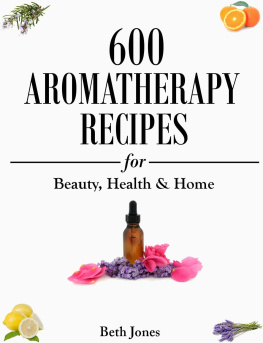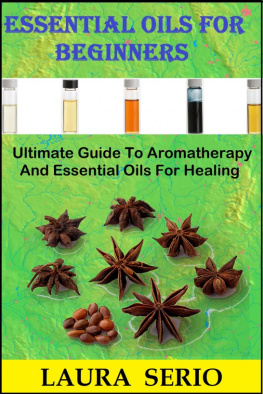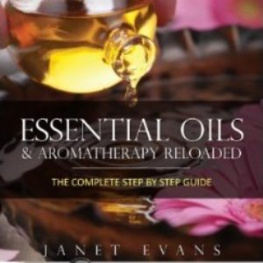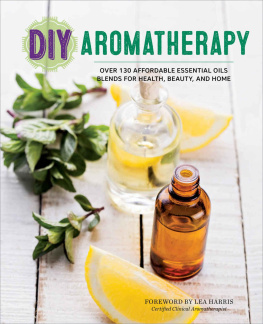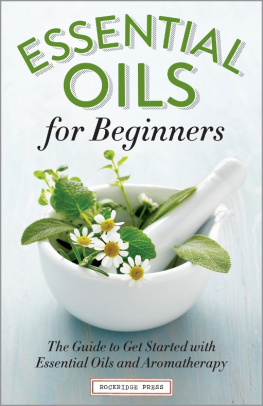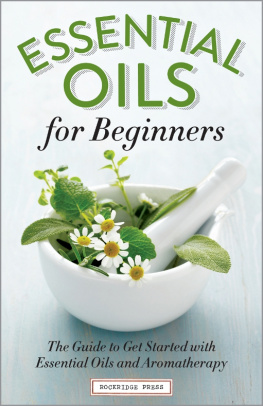600 Aromatherapy Recipes
for
Beauty, Healthy & Home
by
Beth Jones
COPYRIGHT
Copyright 2014 by Beth Jones
All rights reserved. No part of this publication may be reproduced, stored in a retrieval system or transmitted in any form or by any means without the prior permission in writing of the publisher, nor be circulated in writing of any publisher, nor be otherwise circulated in any form of binding or cover other than that in which it is published without a similar condition including this condition, being imposed on the subsequent purchaser.
Before reading or following any of the recipes in this book, it is very important to familiarize yourself with the safety guidelines outlined in Chapter 9. Essential oils are highly concentrated liquids and can be harmful if used incorrectly. All safety guidelines must be strictly followed. The author is not responsible for any mishandling or negligence by the user while using any of the recipes in this book. All oils must be allergy tested before use and the onus is on the user to carry out allergy testing. The safety guidelines, outlined in Chapter 9, are not a complete safety reference for the use of essential oils, if in doubt, a doctor or physician must be consulted regarding any health issues.
First published July 2014
ISBN-13: 978-1499723625
ISBN-10: 1499723628
This book has been produced for the Amazon Kindle and is distributed by Amazon Direct Publishing.
Other Books by Beth Jones
1,001 Ways to Use Essential Oils - including 61 Essential Oils
Introduction
Aromatherapy is the use of essential oils, extracted from various parts of aromatic plants and trees, to promote health of the body and serenity of mind. It is considered a holistic therapy, which makes use of the various properties of these oils, incorporating them into various forms of treatment, aimed at restoring and maintaining health.

Like all holistic therapies, aromatherapy seeks to strengthen the body's own innate self-healing ability, aiming to restore balance, both physically and psychologically. It views disease or disorder as the result of an imbalance in the body or mind, and strives to correct this. This imbalance usually occurs when a person moves further away from a more 'natural' way of living, which may involve eating the wrong foods, lack of exercise or allowing the mind to become preoccupied with negative thoughts. Making appropriate lifestyle changes is an important part of an aromatherapy treatment, and will greatly compliment the properties of essential oils, helping to speed healing. Aromatherapy treatments may take the form of;
- An aromatherapy massage, which is not only the most cost effective and safest way of introducing oils to the body, but it also includes the values of the actual massage therapy itself, and the importance of therapeutic touch.
- The oils may also be incorporated into a bath
- Used on a compress
- Used as inhalations
- They can be used in an oil burner, which can produce a wonderful fragrant atmosphere in a room, are a valuable addition to any beauty routine being used in both the care of skin and hair, and can make highly pleasant perfumes when applied to the skin.
These oils can expel their physical and psychological benefits, regardless of what form of treatment is used, as their effects are exerted both by the absorption of minute quantities of the oil through the skin, and inhalation of the evaporated oil into the lungs from the air.

Although each essential oil will have individual properties and characteristics of its own, they are all antiseptic and most are also endowed with anti-viral or anti-inflammatory properties. They promote natural healing by stimulating and reinforcing the body's' own mechanisms, and exert an influence over the central nervous system. Some will help others stimulate, while some have the ability to normalize or balance the system. Certain oils have the remarkable ability to stimulate the growth and regeneration of skin cells, useful both in healing and rejuvenation. They aim to strengthen the immune system, and although certain oils have the ability to exert their influence very strongly in all of the above conditions, all essential oils have these properties to some extent, as well as other individual characteristics. Aromatherapy is therefore a valuable form of holistic treatment, working to free the body's' own innate healing force, thereby allowing balance to be restored, a state of equilibrium in which disease or disorder cannot manifest. It is a natural, gentle therapy, which once practiced in a controlled and professional manner, can do much to re-balance the body and mind. A most fascinating aspect of aromatherapy is the influence of aroma on the mind and emotions, due to the mind-body link. An alteration in the emotional state will often bring about a beneficial change in the physical body as well, making aromatherapy a valuable treatment for the whole person.

1
About Essential Oils
Essential oils are the basic materials of the aromatherapist, and although sometimes referred to as essences, this description is incorrect, as the essence is what is actually produced by the plant, becoming known as an essential oil only after distillation. This process causes certain chemical changes to take place in the various constituents of the essence, but the therapeutic value is not harmed and even seems to be enhanced. In the same vein, although the term 'essential oils' is used loosely to describe all the oils used in Aromatherapy, those obtained by methods other than distillation should not, strictly speaking, be so called. The citrus oils, for example, extracted by simple pressure, are still in the form of the simple essence when we use them, whereas the floral oils of Jasmine, Neroli and Rose, obtained by enfleurage, should rightly be classed as Absolutes. However the term essential oil is generally used to describe these odoriferous, volatile liquid components of plants, which accumulate in specialized cells in specific parts of the plant, seeds, leaves, flowers, bark, roots or resin etc.The proportion of essence contained in a plant will vary a great deal from species to species, which accounts in part for the varying prices of essential oils, the amounts also varying according to the growing conditions and the time of harvesting. Sometimes different oils, with different therapeutic properties, can be extracted from different parts of the same plant. The orange tree, for example, produces Neroli from the blossom, Petitgrain from the leaves and Orange oil from the skin of the fruit. Essential oils are said to be produced by the plant for its own survival, to repel predators and protect itself from disease. They are said to influence fertilization of the plant by attracting pollinating insects, and in this way could be likened to the pheromones secreted by humans and animals. Another line of thought is that they are actually the hormones of the plant, and influence growth and production in the plant itself, in much the same way as our hormones influence us. This seems realistic as the quantity of hormones produced during the whole lifetime of an individual could quite easily be compared to that produced by a single plant in its lifetime.Due to this relationship, essential oils can be used to balance the human body, through their effects on our hormones, either duplicating or potentiating their effects, whatever is required to restore harmony. They have the added benefit of being organic substances which blend in well with the body, unlike inorganic substances or drugs which may be liable to cause quite severe side-effects.

